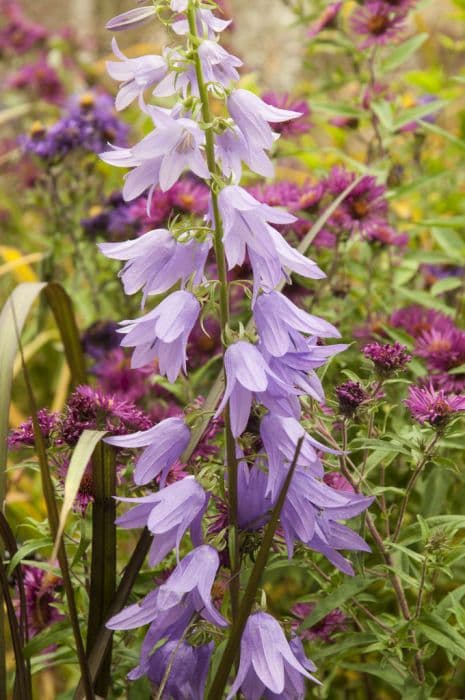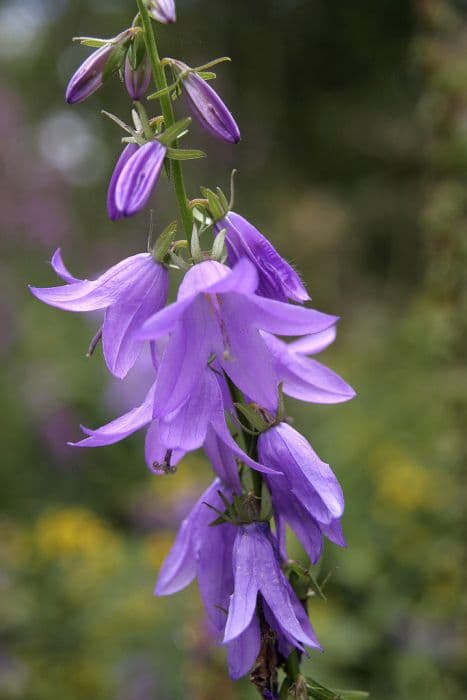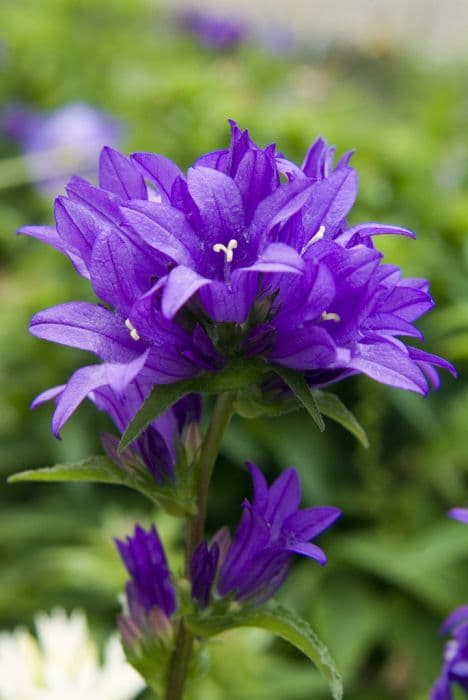Fan Lobelia Lobelia × speciosa

ABOUT
The Lobelia × speciosa, commonly known for its showy blooms, is a striking sight in any garden setting. The plant boasts a profusion of flowers, which are typically shaped like tubes and flare out into two lips. The upper lip usually divides into two lobes, while the lower lip parts into three. These blossoms can appear in a range of colors, most commonly in vibrant hues of red, pink, purple, or white, and they tend to have a gradient or variegated pattern that adds to their visual allure. The foliage of the Lobelia × speciosa provides a lush backdrop to the vivid flowers. The leaves are typically narrow and lance-shaped, with a slightly serrated edge, giving them a slightly ragged appearance. They grow in an alternating pattern along the stems, which adds to the plant's overall texture and fullness. This plant tends to form a bushy clump, with the flowers densely clustered, creating spots of intense color that can visually dominate the area where they are planted. The stems can be upright or branching, supporting the weight of the numerous flowers. Overall, the Lobelia × speciosa presents a bold and colorful display that is both eye-catching and elegant, making it a favorite choice for gardeners looking to add a splash of color to their landscape.
About this plant
 Names
NamesFamily
Campanulaceae
Synonyms
Hybrid Lobelia, Speciosa Lobelia, Showy Lobelia, Garden Lobelia, Trailing Lobelia
Common names
Lobelia × speciosa.
 Toxicity
ToxicityTo humans
The plant commonly known as Fan Lobelia can be toxic if ingested in significant amounts due to the presence of alkaloids such as lobeline. Symptoms of poisoning may include nausea, vomiting, diarrhea, cough, dizziness, excessive salivation, and weakness. In severe cases, it can lead to convulsions, coma, and even death due to respiratory failure.
To pets
Fan Lobelia is also toxic to pets, including dogs and cats. Symptoms of ingestion can mirror those seen in humans, such as vomiting, diarrhea, excessive salivation, and weakness. In severe instances, it can cause more serious signs like difficulty breathing, convulsions, and could potentially be fatal if not treated by a veterinarian.
 Characteristics
CharacteristicsLife cycle
Perennials
Foliage type
Deciduous
Color of leaves
Green
Flower color
Varies
Height
2-3 feet (0.61-0.91 meters)
Spread
1-2 feet (0.30-0.61 meters)
Plant type
Herb
Hardiness zones
6
Native area
North America
Benefits
 General Benefits
General Benefits- Attracts Pollinators: Lobelia speciosa is favored by hummingbirds, butterflies, and bees, which are essential for pollination.
- Aesthetic Appeal: With its striking spires of vibrant flowers, it adds color and visual interest to gardens.
- Easy to Grow: It's known for being relatively easy to cultivate, suitable for gardeners of all skill levels.
- Versatile Planting: Suitable for beds, borders, containers, and waterside plantings, offering many landscaping options.
- Drought Tolerance: Once established, it can tolerate periods of drought, reducing the need for frequent watering.
- Deer Resistance: Tends to be resistant to deer, which can be beneficial in areas where deer grazing is a problem for gardens.
 Medical Properties
Medical Properties- This plant is not used for medical purposes.
 Air-purifying Qualities
Air-purifying QualitiesThis plant is not specifically known for air purifying qualities.
 Other Uses
Other Uses- Lobelia can be used as a natural insect repellent in gardens due to its unique scent which some insects find unappealing.
- Garden designers often use Lobelia as a transition plant to create smooth visual flows between bold color schemes in a garden setting.
- The plant is sometimes used for educational purposes in botany classes, demonstrating plant structure and the growth habits of herbaceous perennials.
- In some areas, Lobelia is included in "green" roof plantings, which aims to provide ecological benefits such as habitat for wildlife and temperature regulation for buildings.
- The bright and striking flowers of Lobelia can be used in the dye-making process for creating natural dyes for fabrics or arts and crafts.
- Lobelia's unique appearance makes it a favored subject for photographers and artists, especially those specializing in botanical themes.
- The plant's texture and shape allow it to be used in dried flower arrangements, maintaining its structure and color for extended periods.
- Some cultures may use Lobelia petals as a decorative element in food plating or as a natural confetti for celebrations, due to their vibrant and appealing color.
- Lobelia can serve as a companion plant, helping to attract pollinators such as bees and butterflies to gardens, which benefits the pollination process of surrounding plants.
- In educational settings, Lobelia can be used to teach propagation techniques, such as division and softwood cuttings, to students learning horticulture and gardening.
Interesting Facts
 Feng Shui
Feng ShuiThe Cardinal Flower is not used in Feng Shui practice.
 Zodiac Sign Compitability
Zodiac Sign CompitabilityThe Cardinal Flower is not used in astrology practice.
 Plant Symbolism
Plant Symbolism- Distinction: The plant Lobelia × speciosa, commonly known as the Cardinal Flower, often symbolizes distinction due to its striking appearance and unique flower shape, making it stand out in gardens and natural settings.
- Attraction: With its vibrant red flowers, the Cardinal Flower is associated with attraction, drawing in both people and hummingbirds, to which it is particularly appealing.
- Devotion: The intense color of the Cardinal Flower has been linked with deep feelings of devotion and love, representing passion and dedication in relationships.
- Vibrancy: The Cardinal Flower exemplifies vibrancy and energy, with its bright color and lively presence in a garden symbolizing high spirits and enthusiasm.
 Water
WaterCardinal Flower should be watered thoroughly, allowing the top inch of soil to dry out slightly before watering again. During the growing season, water about 1 to 2 gallons per week depending on the weather; hotter, drier periods may require more frequent watering. It’s essential not to let the soil become waterlogged, so ensure good drainage. In pots, water until it runs freely from the bottom but don't let the plant sit in water. During the winter, reduce watering, but do not allow the plant to completely dry out.
 Light
LightThe best light conditions for Cardinal Flower involve placing it in partial shade to full sun. An ideal spot would be one that receives morning sunlight and partial shade during the intense afternoon heat. Ensure the plant is protected from the harsh midday sun, which can scorch the leaves, especially in hotter climates.
 Temperature
TemperatureCardinal Flower thrives in temperatures between 60 and 70 degrees Fahrenheit but can tolerate a range between 50 and 85 degrees Fahrenheit. Avoid exposing the plant to temperatures below 50 degrees Fahrenheit, as it can lead to damage or death of the plant. The ideal temperature range offers the plant a balanced environment to grow without stress from excessive heat or cold.
 Pruning
PruningPrune Cardinal Flower to promote bushier growth and remove spent flower spikes, which encourages a second bloom in the season. The best time for pruning is after the first flush of flowers fade, typically in midsummer. Cutting back the foliage in late winter or early spring can revitalize the plant and prepare it for new growth.
 Cleaning
CleaningAs needed
 Soil
SoilCardinal flower prefers moist, well-drained soils with a mix of peat moss, perlite, and garden loam at a pH of 6.0-7.0 for optimal growth.
 Repotting
RepottingCardinal flowers do not generally require frequent repotting; it should be done every 2-3 years or when the plant has outgrown its current container.
 Humidity & Misting
Humidity & MistingCardinal flower thrives best in environments with high humidity, though it can tolerate average room humidity if the soil is kept consistently moist.
 Suitable locations
Suitable locationsIndoor
Ensure high humidity and moist soil for indoor cardinal flowers.
Outdoor
Plant cardinal flowers in partial shade with moist, rich soil.
Hardiness zone
4-9 USDA
 Life cycle
Life cycleThe life of the Lobelia × speciosa, commonly known as Fan Lobelia, begins with seed germination, which occurs in moist, well-draining soil in a location with partial to full sunlight. Seedlings emerge and grow into juvenile plants, developing a basal rosette of leaves before sending up erect stems. During the vegetative growth stage, the plant develops its characteristic lance-shaped leaves and elongates its stems in preparation for flowering. Flowering occurs in summer to early fall, showcasing spiked inflorescences with vibrant reddish-purple flowers that attract pollinators such as bees, butterflies, and hummingbirds. After pollination, Fan Lobelia produces seed capsules that ripen, disperse seeds for future generations, and complete the plant’s reproductive cycle. Over time, Lobelia × speciosa may form clumps through vegetative propagation, as offsets develop from the base, gradually expanding the plant's presence in its growing environment.
 Propogation
PropogationPropogation time
Spring to Summer
Propogation: The most popular method of propagating the Lobelia × speciosa, commonly known as Fan Lobelia, is through seed sowing. Seeds can be started indoors about 10 to 12 weeks before the last frost date. To ensure a good germination rate, seeds need to be surface sown onto moist soil as they require light to germinate, therefore not covering them with soil after sowing is crucial. The pot or tray should be kept in a warm place with a temperature of about 70 to 75 degrees Fahrenheit (21 to 24 degrees Celsius) and in a bright condition without direct sunlight. Germination usually occurs within 14 to 21 days. Once seedlings have grown strong enough and the threat of frost has passed, they can be transplanted outside into their final growing positions. This method allows for a robust and diverse array of plants, although they may not breed true to the parent plant due to hybridization.









